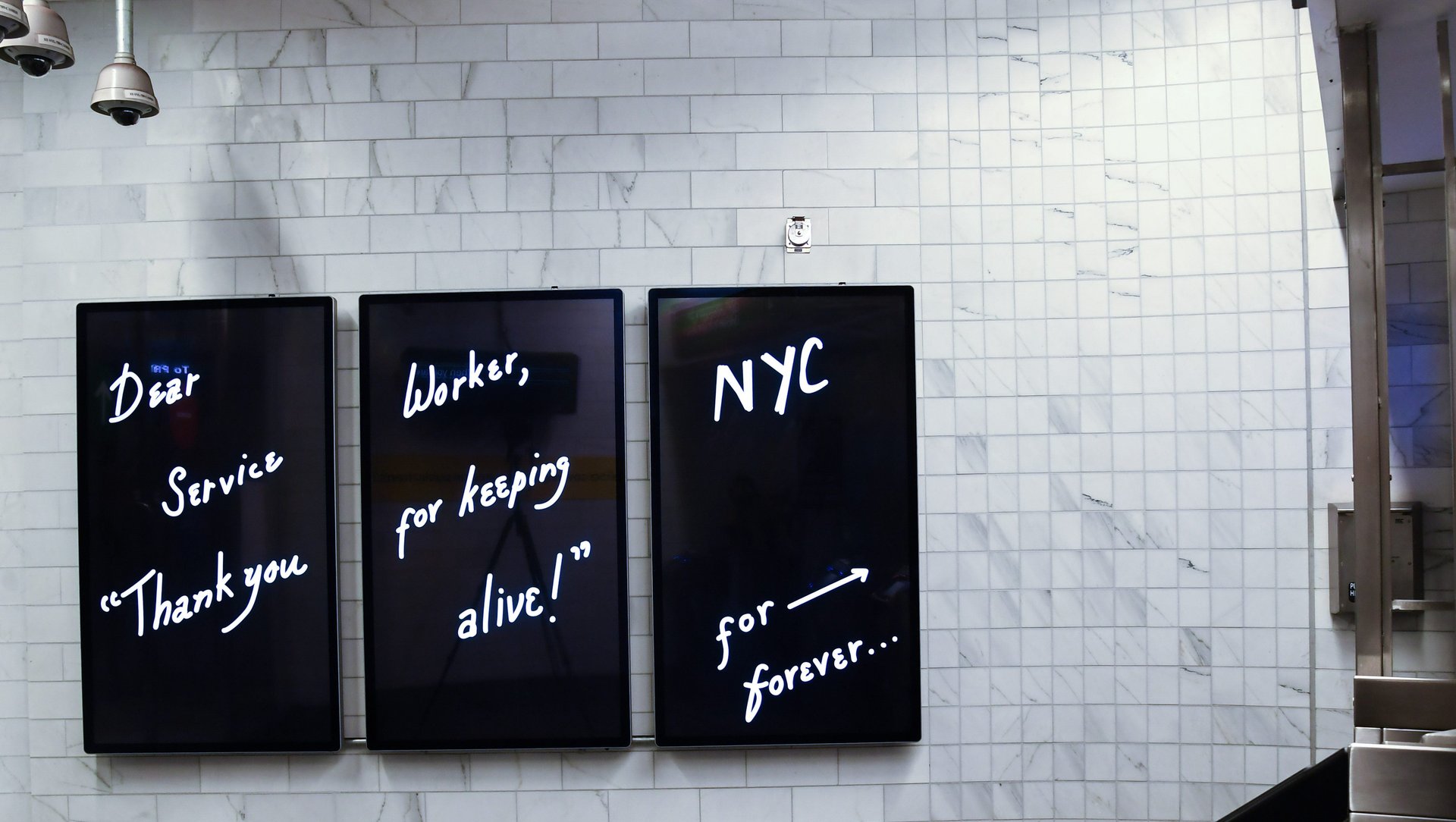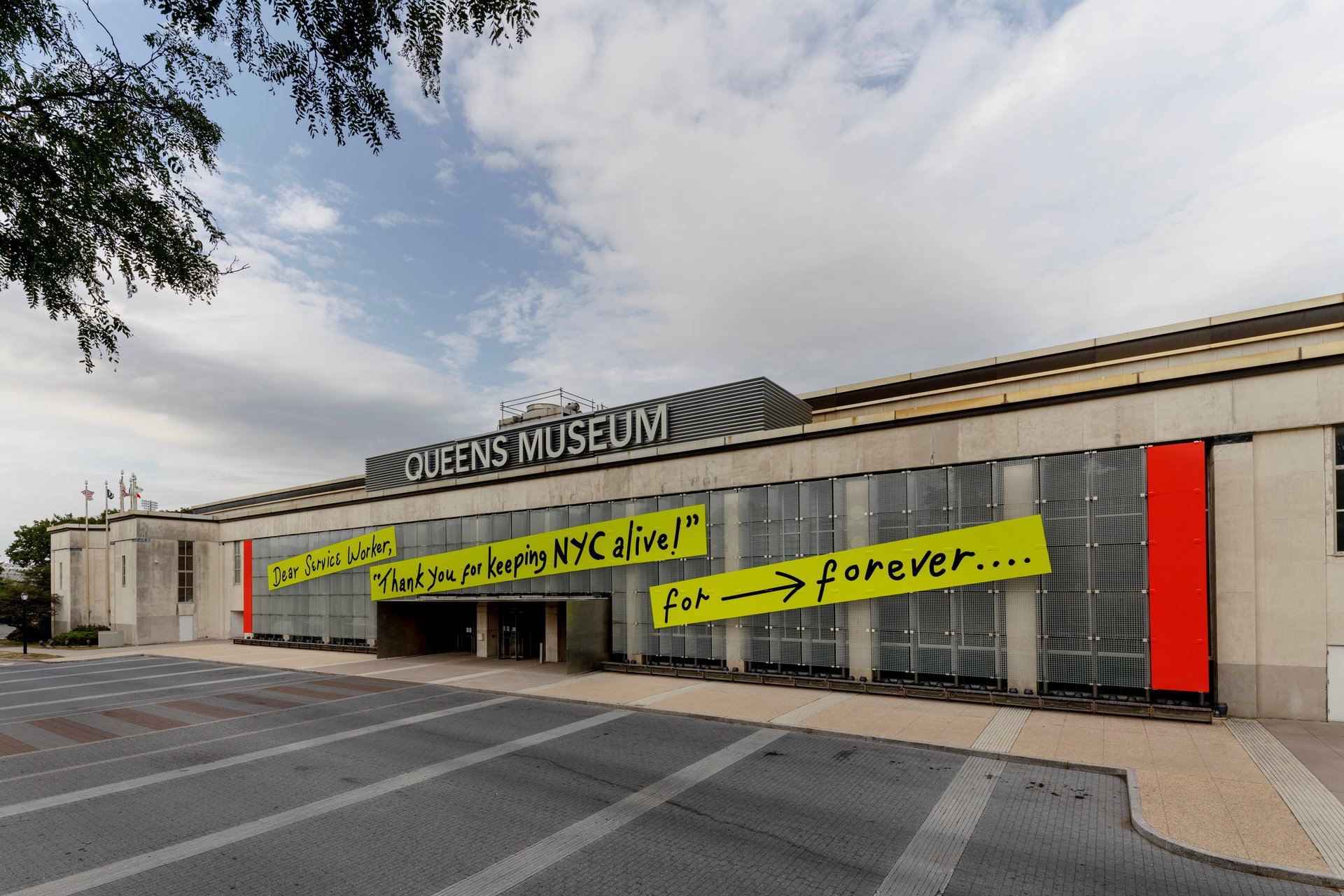The most poignant art in New York right now is from the city sanitation department
To the delight of art lovers, many of New York City’s major museums have reopened. The Metropolitan Museum of Art, the Museum of Modern Art, and the Whitney all have brilliant new exhibitions that serve to transport us from the grim realities of a global pandemic.


To the delight of art lovers, many of New York City’s major museums have reopened. The Metropolitan Museum of Art, the Museum of Modern Art, and the Whitney all have brilliant new exhibitions that serve to transport us from the grim realities of a global pandemic.
Arguably, this season’s most poignant art exhibition can be seen outside the walls of these institutions. In subway stations, on a giant screen in Times Square, and splayed across the façade of the Queens Museum is artist Mierle Laderman Ukeles’s latest piece, lionizing the everyday heroism of the city’s essential workers, who reported to work through the months of lockdown.

“I didn’t know how to make any sense of this pandemic. I just felt that our world went away and left people vulnerable,” Ukeles told Quartz from Israel, where she was quarantined with family. “Then, I read about the plight of New York’s subway workers. They suffered huge losses,” she says referring to the 127 New York transit workers who died from coronavirus-related causes. “They place their bodies out there every single day to keep the city flowing yet they are not often not seen or appreciated.”

On the surface, Ukeles’s digital art piece, titled For ——> forever…, looks plain, even timid—easy to miss against the backdrop of New York’s typically busy urban fabric. Rendered in the 80-year-old artist’s handwriting, the message says: Dear Service Worker, “Thank you for keeping NYC alive!” For —–> forever… They are kind words of course, but their greatest poignancy lies in the context of Ukeles’s body of work.
As the New York City’s Sanitation Department’s first and only artist-in-residence, Ukeles, who has held the role since 1977, has an oeuvre which she calls “maintenance art,” and it is a meditation on the nobility and genius of service workers. She encapsulates its tenets in a searing 1969 manifesto:
Maintenance is a drag; it takes all the fucking time. The mind boggles and chafes at boredom. The culture confers lousy status on maintenance jobs=minimum wage, housewives=no pay.
Ukeles says the injustices experienced by garbage collectors and service crews resonated with her anger as a feminist and a mother. “It was this pissed-offness that really brought us together,” she tells Quartz.
The text of For ——> forever… recalls a performance art piece Ukeles did during New York’s fiscal crisis in 1970s, when the city was in the throes of a severe economic downturn, high crime rates, and low morale. In a piece called Touch Sanitation Performance, Ukeles visited the city’s 8,500 sanitation workers in their place of work over the course of 11 months and offered to shake their hands in gratitude.
Ukeles confesses that she was worried that For ——> forever… might come off as hollow, in the same way that some Covid-19 front-liners came to disdain the nightly applause meant to honor them. “When I saw the piece splashed across 200 feet at the Queens Museum, I thought to myself, is this a shallow gesture? But I want people to have a sense of the people who are keeping New York alive. I hope the work comes across as that.”

Sally Tallant, president and executive director of the Queens Museum, says Ukeles had been on her mind from the start of the quarantine. “When we closed the museum doors in March, we immediately thought of Mierle,” she says. “She’s an important artist who really committed her life and her practice to making visible the labor of maintenance and infrastructure workers.”
Tallant had become deeply familiar with Ukeles’s art when the museum mounted a major exhibition of her work in 2016. It was she who suggested forging a partnership with the cultural programming arm of the Metropolitan Transit Authority and Times Square to get more visibility for Ukeles’s latest piece.
“It makes it more important because we get to use the city’s infrastructure,” Tallant says. “Hopefully, the message will reach the people it’s addressing.” For ——> forever… currently plays on loop at 2,000 digital displays throughout the subway and rail system and pops up every 15 minutes on the large-scale digital billboard in the heart of Times Square.
The job of an artist in residence
Ukeles’s work as artist-in-residence at the New York City Sanitation Department, an unsalaried position, not only illuminates the unheralded heroism of maintenance workers but also their technical acuity. Seen through an artist’s eyes, a worker operating a mechanical sweeper can look like a ballet dancer; a landfill can be a venue for an urban earthworks installation. “In the sanitation department are people trained in mechanical skills like electricians, painter, carpenters,” she explains. Over the 40-plus years she has been involved, “the position has been a great opportunity to do many different kinds of work,” she says.
In 1983, Ukeles pitched to the mayor’s offie a program called Public Artists in Residence (PAIR), allowing each department to earmark a budget for artists to participate in their work. The city adopted the program in 2015 and now has opportunities for artists to “propose and implement creative solutions to pressing civic challenges,” as explained in the program’s call for applications.
“Why did I propose it? Because I wanted to get paid at the sanitation department, which was opening itself up to me in the middle of a fiscal crisis where their budget was getting cut all the time,” she explains. “They said to me, well, Ukeles, if we pay, you we’d have to cut a sanitation worker. You don’t want that do you?”
Her position is unpaid. But Ukeles says artists who want to do work at grand scales should still consider working with government bodies. “All these municipal systems are fabulous—fabulous materials, people, spaces. If you want to work big and you want to work in the public realm, this is a great opportunity.”